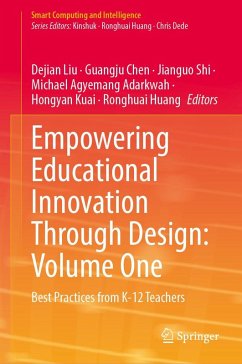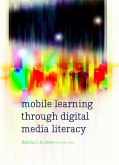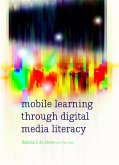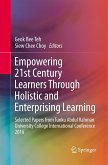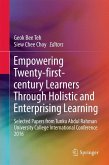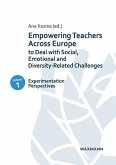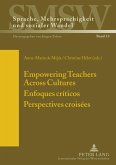Empowering Educational Innovation Through Design: Volume One
Best Practices from K-12 Teachers
Herausgeber: Liu, Dejian; Huang, Ronghuai; Kuai, Hongyan; Adarkwah, Michael Agyemang; Shi, Jianguo; Chen, Guangju
Empowering Educational Innovation Through Design: Volume One
Best Practices from K-12 Teachers
Herausgeber: Liu, Dejian; Huang, Ronghuai; Kuai, Hongyan; Adarkwah, Michael Agyemang; Shi, Jianguo; Chen, Guangju
- Gebundenes Buch
- Merkliste
- Auf die Merkliste
- Bewerten Bewerten
- Teilen
- Produkt teilen
- Produkterinnerung
- Produkterinnerung
This book showcases the best practices and educational innovations from K-12 teachers. It consists of 24 chapters, exploring themes such as evaluation and management platforms, inclusive online classrooms, indigenized service-learning initiatives, school-family-community educational models, and learning style transformation through subject-based classrooms. By illustrating these K-12 best practices, this book serves as an invaluable resource for teachers, students, researchers, and other stakeholders, inspiring them to fully leverage technology in designing educational innovations. If you are…mehr
Andere Kunden interessierten sich auch für
![Mobile Learning through Digital Media Literacy Mobile Learning through Digital Media Literacy]() Belinha S. de AbreuMobile Learning through Digital Media Literacy107,25 €
Belinha S. de AbreuMobile Learning through Digital Media Literacy107,25 €![Mobile Learning through Digital Media Literacy Mobile Learning through Digital Media Literacy]() Belinha S. de AbreuMobile Learning through Digital Media Literacy60,15 €
Belinha S. de AbreuMobile Learning through Digital Media Literacy60,15 €![Empowering 21st Century Learners Through Holistic and Enterprising Learning Empowering 21st Century Learners Through Holistic and Enterprising Learning]() Empowering 21st Century Learners Through Holistic and Enterprising Learning113,99 €
Empowering 21st Century Learners Through Holistic and Enterprising Learning113,99 €![Empowering 21st Century Learners Through Holistic and Enterprising Learning Empowering 21st Century Learners Through Holistic and Enterprising Learning]() Empowering 21st Century Learners Through Holistic and Enterprising Learning113,99 €
Empowering 21st Century Learners Through Holistic and Enterprising Learning113,99 €![Empowering Teachers Across Europe to Deal with Social, Emotional and Diversity-Related Challenges Empowering Teachers Across Europe to Deal with Social, Emotional and Diversity-Related Challenges]() Empowering Teachers Across Europe to Deal with Social, Emotional and Diversity-Related Challenges34,90 €
Empowering Teachers Across Europe to Deal with Social, Emotional and Diversity-Related Challenges34,90 €![Instructional Design: The ADDIE Approach Instructional Design: The ADDIE Approach]() Robert Maribe BranchInstructional Design: The ADDIE Approach91,99 €
Robert Maribe BranchInstructional Design: The ADDIE Approach91,99 €![Empowering Teachers Across Cultures- Enfoques críticos- Perspectives croisées Empowering Teachers Across Cultures- Enfoques críticos- Perspectives croisées]() Empowering Teachers Across Cultures- Enfoques críticos- Perspectives croisées60,50 €
Empowering Teachers Across Cultures- Enfoques críticos- Perspectives croisées60,50 €-
-
-
This book showcases the best practices and educational innovations from K-12 teachers. It consists of 24 chapters, exploring themes such as evaluation and management platforms, inclusive online classrooms, indigenized service-learning initiatives, school-family-community educational models, and learning style transformation through subject-based classrooms. By illustrating these K-12 best practices, this book serves as an invaluable resource for teachers, students, researchers, and other stakeholders, inspiring them to fully leverage technology in designing educational innovations. If you are interested in learning more about this topic, please refer to Volume Two: 'Empowering Educational Innovation Through Design: Volume Two, Practices from University Students'.
Produktdetails
- Produktdetails
- Verlag: Springer Singapore / Springer-Verlag GmbH
- Artikelnr. des Verlages: 89559617
- Seitenzahl: 330
- Erscheinungstermin: 8. Februar 2026
- Englisch
- Abmessung: 235mm x 155mm
- ISBN-13: 9789819546206
- ISBN-10: 9819546206
- Artikelnr.: 75628116
- Herstellerkennzeichnung
- Springer-Verlag GmbH
- Tiergartenstr. 17
- 69121 Heidelberg
- ProductSafety@springernature.com
- Verlag: Springer Singapore / Springer-Verlag GmbH
- Artikelnr. des Verlages: 89559617
- Seitenzahl: 330
- Erscheinungstermin: 8. Februar 2026
- Englisch
- Abmessung: 235mm x 155mm
- ISBN-13: 9789819546206
- ISBN-10: 9819546206
- Artikelnr.: 75628116
- Herstellerkennzeichnung
- Springer-Verlag GmbH
- Tiergartenstr. 17
- 69121 Heidelberg
- ProductSafety@springernature.com
Dr. Dejian Liu is the Chairman and Executive Director of NetDragon Websoft Inc., and Co-Dean of the Smart Learning Institute of Beijing Normal University, China. He also serves on the Governing Board of the UNESCO (United Nations Educational, Scientific and Cultural Organization) Institute for Information Technologies in Education (IITE), and as the Chairman of the Judging Committee for the Global Competition on Design for Future Education (GCD4FE). Dr. Liu also pioneered 'Design Methodology', an innovative design theory grounded in advanced design concepts and practical cyberlearning experiences worldwide. In 2017, he taught the course 'Next Generation Design: Methods and Heuristics' to students from the Harvard Graduate School of Education. Dr. Guangju Chen is the Former Vice President of Beijing Normal University (BNU), and President of Beijing Normal University Zhuhai (BNUZ), China. He is also the Deputy Dean of the Smart Learning Institute of BNU, and Chairman of the Steering Committee, Global Competition on Design for Future Education (GCD4FE). Dr. Jianguo Shi is the Executive Vice President of the Research Institute of China Educational Equipment Industry Association, and an specially-appointed Expert at the Smart Learning Institute, Beijing Normal University, China. He has served as a middle school mathematics teacher, a mathematics curriculum researcher, and Director of the Educational Technology Center of Zhejiang Province. He has been engaged in research and practice on educational technology equipment and educational informatization for many years. In recent years, he has published 40 academic papers in educational technology journals, and has won the Second Prize for National Basic Education Teaching Achievements twice. Dr. Michael Agyemang Adarkwah is a Research Associate at the Institute for Education and Culture, the Chair of Adult Education, Friedrich Schiller University Jena, Germany, and was a Postdoctoral Researcher at the Smart Learning Institute, Beijing Normal University (BNU), China. He serves as an Editor of the book series Assessment of Educational Technology (AET), a Senior Editor for Frontiers of Digital Education, and an Associate Editor for SN Social Sciences, the Journal of Applied Learning and Teaching (JALT), and the Journal of University Teaching and Learning Practice (JUTLP). Ms. Hongyan Kuai is the Director of the Design and Learning Lab, Smart Learning Institute of Beijing Normal University, China, and her research focuses on educational technology and educational design. For over a decade, she has participated in the planning and organizing of the Global Competition on Design for Future Education (in its eighth edition as of 2025), which has attracted over 10,000 college students and K-12 teachers from more than 35 countries and regions. She has also planned and organized various academic events such as the Global Smart Education Conference (now in its tenth edition as of 2025), student forum on the global future education, and the annual Academic Week on Smart Learning. Dr. Ronghuai Huang is a Professor of Education at Beijing Normal University, China. He is the Co-Dean of the Smart Learning Institute of Beijing Normal University, the Director of the National Engineering Research Center of Cyberlearning and Intelligent Technology, and the Director of the Educational Informatization Strategy Research Base in Beijing, under the Ministry of Education of the People's Republic of China. Additionally, he serves as the UNESCO Chair on Artificial Intelligence in Education. Professor Huang has undertaken over 100 vertical and horizontal research projects at national and provincial levels, published more than 40 academic books worldwide, and authored over 400 academic papers in Chinese and English.
Foreword.
Preface.
Introduction to the Global Competition on Design for Future Education.
Features of the Book.
Content.
Part 1 Highlighting Educational Product Designs.
Chapter 1 The Data Brain of Small Seeds: A Comprehensive Evaluation System for Students in Large
Scale Schools.
Chapter 2 Construction and Practice of Internet
Enhanced Management Platform for Student Mental Well
being.
Chapter 3 Code Mission: Designing an Educational Tool for Programming Education.
Chapter 4 Integrated Reading: Construction and Implementation of Online, Offline, and Autonomous Reading System.
Chapter 5 AI
Enhanced Education: Creation and Application of Interdisciplinary Instructional Agent.
Part 2 Featuring Educational Solution Designs.
Chapter 6 Ethno
STEAM and Klenang Sasak: A Design
Based Solution for Rural Schools.
Chapter 7 Unity in Diversity: Innovative Practices for Inclusive Education.
Chapter 8 AIGC
Integrated Art Course: Pathway to Cultivate High
Quality Artistic Talents.
Chapter 9 Food Museum: Curriculum and Venue Development for Food Education in Kindergartens.
Chapter 10 Crafting and Deploying a Metaverse Curriculum Leveraging the WorldWide Telescope.
Chapter 11 Magic Space: The Construction and Practical Study of a Comprehensive Learning Space in Schools.
Chapter 12 Teaching Accuracy in English Writing through Process
Oriented Data Feedback Technology.
Chapter 13 Designing a Creative "Smart+" P.E. Class Break Using Educational Neuroscience.
Chapter 14 Developing Health Education Resources for Tibetan Farmers' and Herdsmen's Children Using Digital Technology Applications.
Part 3 Showcase of Educational Service Designs.
Chapter 15 Intelligent After
School Extended Care Programme for Primary School Students.
Chapter 16 Innovative Practices in Cultivating a Sense of Social Responsibility among Rural Students: Taking A Touch of Blue as an Example.
Chapter 17 Indigenized Implementation of Service
Learning in Secondary Schools.
Part 4 Insight into Educational Mechanism Designs.
Chapter 18 Design and Implementation of Multi
Course Blended Teaching in Smart Education.
Chapter 19 Exploring the Collaborative Model of School
Family
Community for Cultivating Creative Talents.
Chapter 20 The Sharing of Educational Resources between Urban and Rural Schools Enabled by Real
scene Classroom.
Part 5 Exploring Educational Policy Designs.
Chapter 21 Enhancing Learning Style Transformation through the Design and Application of Subject
Based Classrooms.
Preface.
Introduction to the Global Competition on Design for Future Education.
Features of the Book.
Content.
Part 1 Highlighting Educational Product Designs.
Chapter 1 The Data Brain of Small Seeds: A Comprehensive Evaluation System for Students in Large
Scale Schools.
Chapter 2 Construction and Practice of Internet
Enhanced Management Platform for Student Mental Well
being.
Chapter 3 Code Mission: Designing an Educational Tool for Programming Education.
Chapter 4 Integrated Reading: Construction and Implementation of Online, Offline, and Autonomous Reading System.
Chapter 5 AI
Enhanced Education: Creation and Application of Interdisciplinary Instructional Agent.
Part 2 Featuring Educational Solution Designs.
Chapter 6 Ethno
STEAM and Klenang Sasak: A Design
Based Solution for Rural Schools.
Chapter 7 Unity in Diversity: Innovative Practices for Inclusive Education.
Chapter 8 AIGC
Integrated Art Course: Pathway to Cultivate High
Quality Artistic Talents.
Chapter 9 Food Museum: Curriculum and Venue Development for Food Education in Kindergartens.
Chapter 10 Crafting and Deploying a Metaverse Curriculum Leveraging the WorldWide Telescope.
Chapter 11 Magic Space: The Construction and Practical Study of a Comprehensive Learning Space in Schools.
Chapter 12 Teaching Accuracy in English Writing through Process
Oriented Data Feedback Technology.
Chapter 13 Designing a Creative "Smart+" P.E. Class Break Using Educational Neuroscience.
Chapter 14 Developing Health Education Resources for Tibetan Farmers' and Herdsmen's Children Using Digital Technology Applications.
Part 3 Showcase of Educational Service Designs.
Chapter 15 Intelligent After
School Extended Care Programme for Primary School Students.
Chapter 16 Innovative Practices in Cultivating a Sense of Social Responsibility among Rural Students: Taking A Touch of Blue as an Example.
Chapter 17 Indigenized Implementation of Service
Learning in Secondary Schools.
Part 4 Insight into Educational Mechanism Designs.
Chapter 18 Design and Implementation of Multi
Course Blended Teaching in Smart Education.
Chapter 19 Exploring the Collaborative Model of School
Family
Community for Cultivating Creative Talents.
Chapter 20 The Sharing of Educational Resources between Urban and Rural Schools Enabled by Real
scene Classroom.
Part 5 Exploring Educational Policy Designs.
Chapter 21 Enhancing Learning Style Transformation through the Design and Application of Subject
Based Classrooms.
Foreword.
Preface.
Introduction to the Global Competition on Design for Future Education.
Features of the Book.
Content.
Part 1 Highlighting Educational Product Designs.
Chapter 1 The Data Brain of Small Seeds: A Comprehensive Evaluation System for Students in Large
Scale Schools.
Chapter 2 Construction and Practice of Internet
Enhanced Management Platform for Student Mental Well
being.
Chapter 3 Code Mission: Designing an Educational Tool for Programming Education.
Chapter 4 Integrated Reading: Construction and Implementation of Online, Offline, and Autonomous Reading System.
Chapter 5 AI
Enhanced Education: Creation and Application of Interdisciplinary Instructional Agent.
Part 2 Featuring Educational Solution Designs.
Chapter 6 Ethno
STEAM and Klenang Sasak: A Design
Based Solution for Rural Schools.
Chapter 7 Unity in Diversity: Innovative Practices for Inclusive Education.
Chapter 8 AIGC
Integrated Art Course: Pathway to Cultivate High
Quality Artistic Talents.
Chapter 9 Food Museum: Curriculum and Venue Development for Food Education in Kindergartens.
Chapter 10 Crafting and Deploying a Metaverse Curriculum Leveraging the WorldWide Telescope.
Chapter 11 Magic Space: The Construction and Practical Study of a Comprehensive Learning Space in Schools.
Chapter 12 Teaching Accuracy in English Writing through Process
Oriented Data Feedback Technology.
Chapter 13 Designing a Creative "Smart+" P.E. Class Break Using Educational Neuroscience.
Chapter 14 Developing Health Education Resources for Tibetan Farmers' and Herdsmen's Children Using Digital Technology Applications.
Part 3 Showcase of Educational Service Designs.
Chapter 15 Intelligent After
School Extended Care Programme for Primary School Students.
Chapter 16 Innovative Practices in Cultivating a Sense of Social Responsibility among Rural Students: Taking A Touch of Blue as an Example.
Chapter 17 Indigenized Implementation of Service
Learning in Secondary Schools.
Part 4 Insight into Educational Mechanism Designs.
Chapter 18 Design and Implementation of Multi
Course Blended Teaching in Smart Education.
Chapter 19 Exploring the Collaborative Model of School
Family
Community for Cultivating Creative Talents.
Chapter 20 The Sharing of Educational Resources between Urban and Rural Schools Enabled by Real
scene Classroom.
Part 5 Exploring Educational Policy Designs.
Chapter 21 Enhancing Learning Style Transformation through the Design and Application of Subject
Based Classrooms.
Preface.
Introduction to the Global Competition on Design for Future Education.
Features of the Book.
Content.
Part 1 Highlighting Educational Product Designs.
Chapter 1 The Data Brain of Small Seeds: A Comprehensive Evaluation System for Students in Large
Scale Schools.
Chapter 2 Construction and Practice of Internet
Enhanced Management Platform for Student Mental Well
being.
Chapter 3 Code Mission: Designing an Educational Tool for Programming Education.
Chapter 4 Integrated Reading: Construction and Implementation of Online, Offline, and Autonomous Reading System.
Chapter 5 AI
Enhanced Education: Creation and Application of Interdisciplinary Instructional Agent.
Part 2 Featuring Educational Solution Designs.
Chapter 6 Ethno
STEAM and Klenang Sasak: A Design
Based Solution for Rural Schools.
Chapter 7 Unity in Diversity: Innovative Practices for Inclusive Education.
Chapter 8 AIGC
Integrated Art Course: Pathway to Cultivate High
Quality Artistic Talents.
Chapter 9 Food Museum: Curriculum and Venue Development for Food Education in Kindergartens.
Chapter 10 Crafting and Deploying a Metaverse Curriculum Leveraging the WorldWide Telescope.
Chapter 11 Magic Space: The Construction and Practical Study of a Comprehensive Learning Space in Schools.
Chapter 12 Teaching Accuracy in English Writing through Process
Oriented Data Feedback Technology.
Chapter 13 Designing a Creative "Smart+" P.E. Class Break Using Educational Neuroscience.
Chapter 14 Developing Health Education Resources for Tibetan Farmers' and Herdsmen's Children Using Digital Technology Applications.
Part 3 Showcase of Educational Service Designs.
Chapter 15 Intelligent After
School Extended Care Programme for Primary School Students.
Chapter 16 Innovative Practices in Cultivating a Sense of Social Responsibility among Rural Students: Taking A Touch of Blue as an Example.
Chapter 17 Indigenized Implementation of Service
Learning in Secondary Schools.
Part 4 Insight into Educational Mechanism Designs.
Chapter 18 Design and Implementation of Multi
Course Blended Teaching in Smart Education.
Chapter 19 Exploring the Collaborative Model of School
Family
Community for Cultivating Creative Talents.
Chapter 20 The Sharing of Educational Resources between Urban and Rural Schools Enabled by Real
scene Classroom.
Part 5 Exploring Educational Policy Designs.
Chapter 21 Enhancing Learning Style Transformation through the Design and Application of Subject
Based Classrooms.

